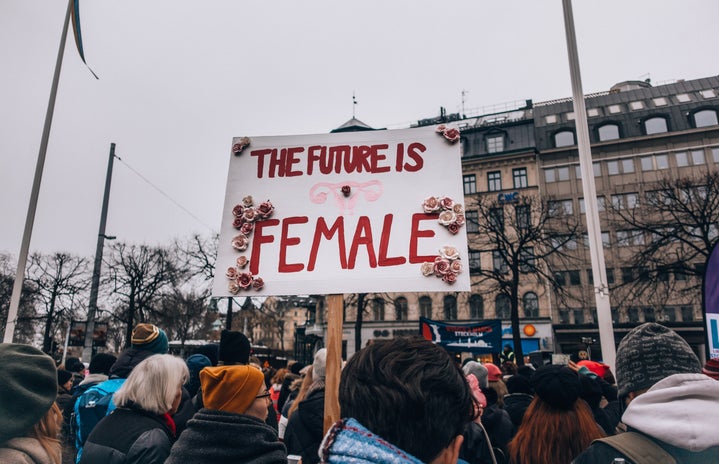Jackson’s Women’s Health Organization is the last standing abortion clinic in the state of Mississippi. In 2018, Mississippi proposed a bill that would ban abortion in the state after 15 weeks. This bill directly contradicts the 1973 Roe v. Wade ruling, which protects the right to abortion in the United States. Jackson’s Women’s Health Organization then sued Thomas Dobbs, the State Health Officer of the Mississippi Department of Health on the basis that the law was unconstitutional. On Dec. 1, 2021 oral arguments in the case were heard by the Supreme Court. We will likely not hear the decision of the court until this summer. Dobbs v. Jackson Women’s Health Organization will be the case to decide the future of abortion rights in the United States.
What is Roe v Wade
In 1968, Jane Roe, real name Norma McCorvey, was 21 years old when she discovered she was pregnant. Already the mother of two children, Roe decided that she was not in the place to care for a third child and wished to terminate the pregnancy. However, abortion was illegal in Texas at the time except in cases of rape or medical necessity. After trying to seek a legal abortion and failing, Roe was contacted by lawyers who wanted to challenge the Texas law. In 1973, years after Roe had given birth and put the baby up for adoption, the case finally reached the Supreme Court of the United States.
The lead lawyer on the case, Sarah Weddington, was only 28 when she argued in front of the Supreme Court. Instead of arguing whether or not abortion was ending a life, she argued that it was a woman’s right to choose to terminate a pregnancy due to the right to privacy implied in the Fourth Amendment. The court sided with Roe seven to two, and abortion became legal in the United States. Under Roe, states may not limit abortion within the first trimester, or twelve weeks can propose regulations that do not place any burden on the woman seeking an abortion in the second trimester (28 weeks) and can only allow abortion due to medical necessity in the third trimester (40 weeks).
The Current State of Abortion in the United States
In 2019, the Center for Disease Control and Prevention conducted a study of abortion data from 47 states and the District of Colombia excluding California, New York and New Hampshire. They reported a total of 629,898 abortions in the year 2019. Of those women who received an abortion, the majority (56.9%) were between 20 and 29. Most abortions (79.3%) occurred within the first nine weeks of pregnancy and almost all (92.7%) before 13 weeks of pregnancy. A decrease was seen in the total number, rate and ratio of reported abortions between 2010 and 2019. Black women accounted for the largest percentage of all abortions at 38.4%, White women accounted for the second-largest percentage at 33.4%, and Hispanic women accounted for 21%. Most of the women, or 58.2%, had not previously had an abortion, and 23% previously had one abortion.
What Happens Next
If Roe is overturned, 26 states will likely outlaw or severely restrict abortion. States like Missouri and Louisiana have trigger bans in place that have already been approved by state legislatures that would ban abortion the minute Roe is overturned. In order to receive an abortion if the trigger ban is put into effect, women in Louisiana will have to travel to Kansas. The same goes for women in Missouri having to travel to Illinois to receive abortion care. Many people, especially low-income women, Indigenous women and people of color, are unable to travel for abortion care, which will lead many women to resort to illegal methods. This will ultimately lead to the same health disaster that occurred before Roe.
In 2021, Texas passed one of the most restrictive abortion bans in the country, which bans abortion after six weeks, before most women know that they are pregnant. The most terrifying part of this law is not the blatant violation of Roe v. Wade but the section of the law allowing for criminal proceedings to be brought against someone who has an abortion or help someone receive an abortion. Women can be charged with homicide or child abuse. Partners of those receiving an abortion can be charged with domestic violence. The abortion provider can be charged with feticide and assault. An Uber or taxi driver can be charged as an accomplice. Anyone can report an abortion they believe to be illegal to the government and could receive a $10,000 “prize” for doing so.
The Danger of Unsafe Abortions
According to the World Health Organization and the Guttmacher Institute, 25 million unsafe abortions take place annually. Of those 25 million, over 22,000 women die as a result. It is important to note that this number only accounts for deaths that are accounted to unsafe abortions, not the several thousand more that go unreported. Between two and seven million women suffer from health effects after an unsafe abortion, including but not limited to incomplete abortion, infection, sepsis and injury to internal organs. It was also concluded that abortion is significantly safer in countries where the procedure is legal rather than illegal.
Looking into the Past
In her 2019 article for the New Yorker, Kate Daloz tells the story of her grandmother, Winifred “Win” Haynes Mayer, who died as a result of an illegal abortion. Daloz’s mother was just a baby when her mother passed away and didn’t learn the truth of her mother’s death until she was in college. As a child, Daloz was told that her grandmother died as the result of a household accident. It wasn’t until she was 12 that Daloz learned from friends what an abortion was, and her mother told her the truth.
Recounting the conversation between Daloz and her mother, she writes:
“I had only just grasped what abortion was a few hours earlier, and was still trying on this new pro-life idea. ‘O.K.,’ I said, ‘but what about the uncle or aunt I never had?’ Mom whipped toward me, face taut with a rage and fear that I somehow understood had nothing to do with me. ‘What about the mother I never had?’ she said.”
Daloz, 2019
Daloz’s grandmother, Win, was born in 1912 and after pressure from her mother, enrolled in the University of Wisconsin, Madison. Win met her soon-to-be husband, Eddie, during her senior year of college, and the two married in 1939. They had their first son in 1941, shortly after Eddie was recruited by the US military and sent to London. When Eddie left for deployment, Win was pregnant with their second child and Daloz’s mother. While at home, Eddie learned that his job would require him to live in Europe indefinitely, and Win discovered that she was unexpectedly pregnant with their third child.
Win had originally sought the help of a friend to terminate her pregnancy, and they planned to travel to New York to receive the procedure at the hands of a doctor. However, when that fell through, Win reached out to her father, who was a doctor, but he unfortunately also refused to help. She had no other choice but to complete the procedure herself. Eddie arrived home to find Win dead on the bathroom floor, both of their children crying for their mother. The official cause of death of Winifred Haynes Mayer was determined a “death due to shock as a result of an attempt to force a miscarriage by mechanical methods,” but the family chose to say that she passed away from embolism.
Kate Daloz ends her article by describing a very similar conversation to the one between herself and her mother. This time the conversation is between Daloz and her seven-year-old daughter after she asked questions about her great-grandmother.
“She needed help really badly and no one would help her so she died,’ I told her. Then I added a reassurance that I’m not sure I’d feel confident offering today. ‘It’s not a thing that would happen to us now,’ I said. ‘If we ever needed that kind of help, we would get it and we would be safe.”
Daloz, 2019
In 1930, unsafe abortion was listed as the official cause of death for 2,700 women, accounting for 1/5th of all maternal deaths for that year. In 1968, the University of Southern California Los Angeles County Medical Center admitted 701 women suffering from septic abortions. That year, the hospital had one abortion-related admission for every 14 deliveries. These are just the numbers that were reported; it’s likely the real number was much higher. Just ten years after Roe was passed, the number of deaths as a result of abortion decreased from 200 to less than 50. The rate for abortion-related deaths between 2013 and 2018 was 0.41 deaths for every 100,000 abortions. My point? Legal abortion saves lives.
When abortion is illegal, low-income women and minorities are the most affected. In the 1960s, low-income women in New York City were polled, and it was found that one in 10 had attempted to terminate a pregnancy illegally. Of those women, 77% had attempted a self-induced procedure. In 1962, 1,600 women were admitted to the Harlem Hospital Center due to an incomplete abortion. BIPOC women are disproportionately at risk of complications due to unsafe and illegal abortions. In the same New York City study, it was found that 25% of maternal deaths of white women were caused by an abortion; however, 50% of maternal deaths of non-white women were the result of an abortion. It is because of this disparity that abortion is not just a women’s rights issue, but also a race issue. Whether it is the intention or not, banning abortion in the United States will have classist and racist effects.
Poland: A Preview of What’s to come
In October of 2020, Poland banned all abortion except in cases of rape or incest. A woman, known only as Agnieszka T., was a mother of two and pregnant with twins when one of the fetus’ hearts stopped beating. She was admitted to the hospital where her doctors refused to remove the fetus because of the recent abortion regulations. Her health quickly deteriorated, and the second fetus’s heart stopped a week later. Doctors were again hesitant to remove the pregnancy and waited two days before the procedure was completed. Three weeks later, Agnieszka died as a result of septic shock. Had that law never passed, Agnieszka would still be alive.
If Roe falls, there will be thousands of stories just like hers.
If the Supreme Court of the United States bans abortion, they will have blood on their hands.
What You Can Do
As a result of the Hyde Amendment, no federal funding for Planned Parenthood goes towards abortions, but you can donate to their abortion fund here.
Contact your congressional representatives and tell them you want them to protect abortion rights here.
Read more about Roe v. Wade here.
Map to see where your state falls on abortion rights here.
Find the closest abortion provider to you here.
Read a similar article to Kate Daloz by Caitlin Flanagan here.
Watch “Reversing Roe,” A documentary on the dangers of illegal abortion here.


